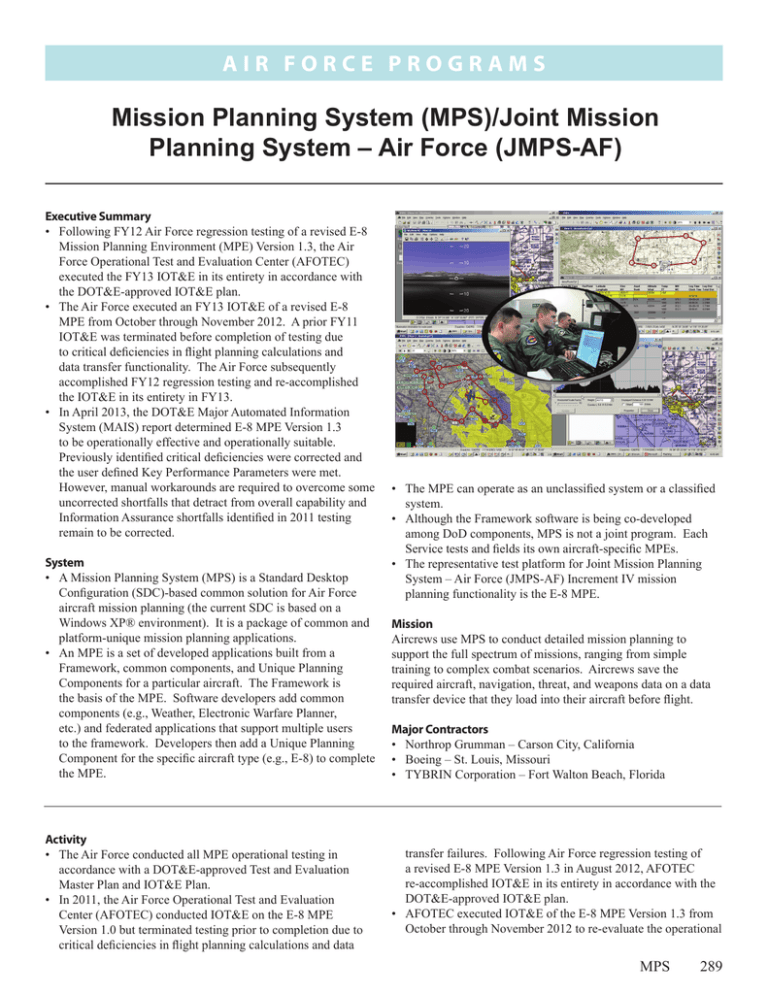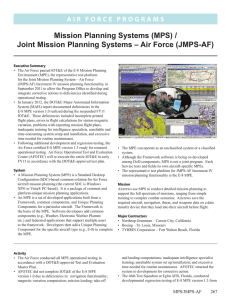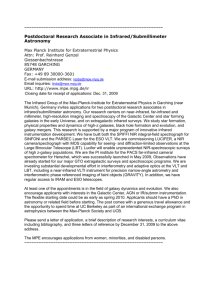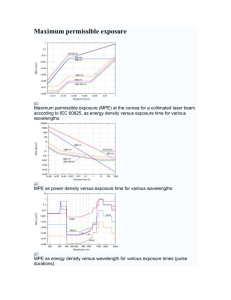Mission Planning System (MPS)/Joint Mission Planning System – Air Force (JMPS-AF)
advertisement

A i r F o r c e P RO G R A M S Mission Planning System (MPS)/Joint Mission Planning System – Air Force (JMPS-AF) Executive Summary • Following FY12 Air Force regression testing of a revised E-8 Mission Planning Environment (MPE) Version 1.3, the Air Force Operational Test and Evaluation Center (AFOTEC) executed the FY13 IOT&E in its entirety in accordance with the DOT&E-approved IOT&E plan. • The Air Force executed an FY13 IOT&E of a revised E-8 MPE from October through November 2012. A prior FY11 IOT&E was terminated before completion of testing due to critical deficiencies in flight planning calculations and data transfer functionality. The Air Force subsequently accomplished FY12 regression testing and re-accomplished the IOT&E in its entirety in FY13. • In April 2013, the DOT&E Major Automated Information System (MAIS) report determined E-8 MPE Version 1.3 to be operationally effective and operationally suitable. Previously identified critical deficiencies were corrected and the user defined Key Performance Parameters were met. However, manual workarounds are required to overcome some uncorrected shortfalls that detract from overall capability and Information Assurance shortfalls identified in 2011 testing remain to be corrected. System • A Mission Planning System (MPS) is a Standard Desktop Configuration (SDC)-based common solution for Air Force aircraft mission planning (the current SDC is based on a Windows XP® environment). It is a package of common and platform-unique mission planning applications. • An MPE is a set of developed applications built from a Framework, common components, and Unique Planning Components for a particular aircraft. The Framework is the basis of the MPE. Software developers add common components (e.g., Weather, Electronic Warfare Planner, etc.) and federated applications that support multiple users to the framework. Developers then add a Unique Planning Component for the specific aircraft type (e.g., E-8) to complete the MPE. Activity • The Air Force conducted all MPE operational testing in accordance with a DOT&E-approved Test and Evaluation Master Plan and IOT&E Plan. • In 2011, the Air Force Operational Test and Evaluation Center (AFOTEC) conducted IOT&E on the E-8 MPE Version 1.0 but terminated testing prior to completion due to critical deficiencies in flight planning calculations and data • The MPE can operate as an unclassified system or a classified system. • Although the Framework software is being co-developed among DoD components, MPS is not a joint program. Each Service tests and fields its own aircraft-specific MPEs. • The representative test platform for Joint Mission Planning System – Air Force (JMPS-AF) Increment IV mission planning functionality is the E-8 MPE. Mission Aircrews use MPS to conduct detailed mission planning to support the full spectrum of missions, ranging from simple training to complex combat scenarios. Aircrews save the required aircraft, navigation, threat, and weapons data on a data transfer device that they load into their aircraft before flight. Major Contractors • Northrop Grumman – Carson City, California • Boeing – St. Louis, Missouri • TYBRIN Corporation – Fort Walton Beach, Florida transfer failures. Following Air Force regression testing of a revised E-8 MPE Version 1.3 in August 2012, AFOTEC re-accomplished IOT&E in its entirety in accordance with the DOT&E-approved IOT&E plan. • AFOTEC executed IOT&E of the E-8 MPE Version 1.3 from October through November 2012 to re-evaluate the operational MPS 289 A i r F o r c e P RO G R A M S effectiveness, suitability, and mission capability of the E-8 MPE. • AFOTEC conducted the 2012 IOT&E due to the discovery of deficiencies during the 2011 IOT&E of the E-8 MPE Version 1.0 that led to termination prior to completion. Problems identified in the earlier IOT&E of Version 1.0 included: navigational functionality; magnetic variation computation; unreliable system set up/installation; and excessive time needed for routine maintenance. Assessment • In April 2013, DOT&E published a MAIS report concluding that E-8 MPE Version 1.3 was operationally effective and operationally suitable. Significant findings include: - Aircrews are able to plan all representative missions well within the required 4-hour time period, and the critical deficiencies identified during the 2011 IOT&E have been corrected. - The system meets the user defined Key Performance Parameters to include flight route creation and manipulation; mission planning time; data transfer device operations; and data exchanges from JMPS workstations to the aircraft. - Manual workarounds are required to overcome some uncorrected shortfalls that detract from overall capability. These shortfalls include the inability to-▪▪ Calculate take-off and landing data ▪▪ Automatically plan in-flight orbits ▪▪ Generate correct printed flight plan materials for routes north of 60 degrees latitude ▪▪ Implement the MPE’s vertical vector obstruction data terrain avoidance planning tools 290 MPS • E-8 MPE Information Assurance shortfalls identified in earlier 2011 DOT&E MAIS reporting remain uncorrected. These deficiencies include the following: - Missing critical software patches - Outdated anti-virus signature definitions - Poor printer authentication - Default guest accounts allowed network access - Internal system communication processes accessible with anonymous credentials - Remotely accessible unauthorized registry paths - Planning computer Basic Input and Output System allowing booting from a Universal Serial Bus device Recommendations • Status of Previous Recommendations. The Air Force is addressing the previous recommendations. However, the Air Force did not automate take-off and landing data capabilities into the MPE tested during the 2012 IOT&E. • FY13 Recommendations. The Air Force should: 1. Address the shortfalls identified in the 2012 IOT&E to enable the E-8 MPE to compute automated take-off and landing data calculation; automatically plan in-flight orbits; correct deficiencies in the E-8 MPE vertical vector obstruction data terrain avoidance planning tools; allow importing threat information with ease; reduce lengthy software installation time; and improve training for JMPS personnel and users 2. Address the uncorrected Information Assurance shortfalls identified in the 2011 DOT&E JMPS E-8 MPE MAIS report.







